3DMet B01331 Related compounds Molar mass 174.2 g/mol | Appearance White crystals Formula C6H14N4O2 | |
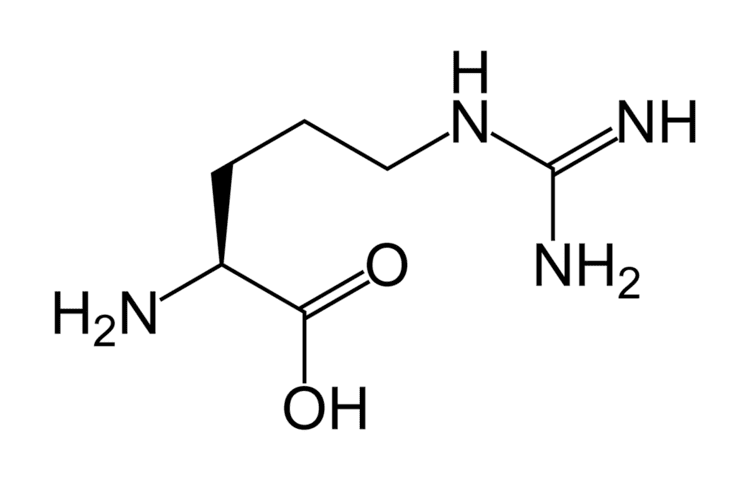 | ||
Related alkanoic acids Thermodynamicdata Phase behavioursolid–liquid–gas IUPAC ID (S)-2-Amino-5-guanidinopentanoic acid | ||
Arginine (abbreviated as Arg or R) encoded by the codons CGU, CGC, CGA, CGG, AGA, and AGG is an α-amino acid that is used in the biosynthesis of proteins.
Contents
- Function
- Proteins
- Precursor
- Treatment of dentin hypersensitivity
- Treatment of herpes simplex virus
- Treatment of peripheral neuropathy
- Safety
- Structure
- Growth hormone
- MELAS syndrome
- High blood pressure
- References
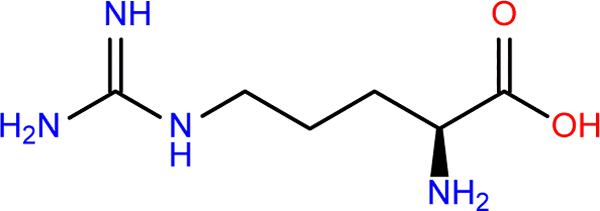
Arginine is classified as a semiessential or conditionally essential amino acid, depending on the developmental stage and health status of the individual. Preterm infants are unable to synthesize or create arginine internally, making the amino acid nutritionally essential for them. Most healthy people do not need to supplement with arginine because their body produces sufficient amounts.

Arginine was first isolated from a lupin seedling extract in 1886 by the German chemist Ernst Schultze. It contains an α-amino group (which is in the protonated −NH3+ form under biological conditions), an α-carboxylic acid group (which is in the deprotonated −COO− form under biological conditions), and a side chain of a 3-carbon aliphatic straight chain capped by a complex guanidinium, classifying it as a charged (at physiological pH), aliphatic amino acid.
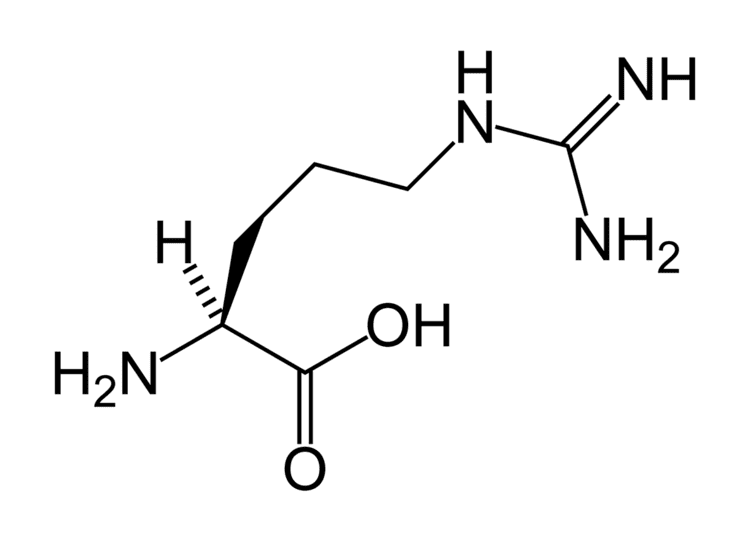
Function
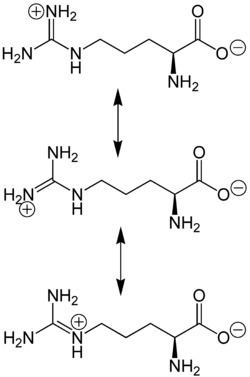
Arginine plays an important role in cell division, the healing of wounds, removing ammonia from the body, immune function, and the release of hormones.
The roles of arginine include:

Proteins
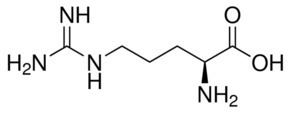
The distributing basics of the moderate structure found in geometry, charge distribution, and ability to form multiple H-bonds make arginine ideal for binding negatively charged groups. For this reason, arginine prefers to be on the outside of the proteins, where it can interact with the polar environment.

Incorporated in proteins, arginine can also be converted to citrulline by PAD enzymes. In addition, arginine can be methylated by protein methyltransferases.
Precursor
Arginine is the immediate precursor of nitric oxide (NO), urea, ornithine, and agmatine; is necessary for the synthesis of creatine; and can also be used for the synthesis of polyamines (mainly through ornithine and to a lesser degree through agmatine), citrulline, and glutamate. As a precursor of nitric oxide, arginine may have a role in the treatment of some conditions where vasodilation is required. The presence of asymmetric dimethylarginine (ADMA), a close relative, inhibits the nitric oxide reaction; therefore, ADMA is considered a marker for vascular disease, just as L-arginine is considered a sign of a healthy endothelium.
Treatment of dentin hypersensitivity
Arginine (8%) in dental products (e.g., toothpaste) provides effective relief from sensitive teeth by depositing a dentin-like mineral, containing calcium and phosphate, within the dentin tubules and in a protective layer on the dentin surface.
Treatment of herpes simplex virus
An unproven claim is that a low ratio of arginine to lysine may be of benefit in the treatment of herpes simplex virus. For more information, refer to Herpes – Treatment also see journal article.
Treatment of peripheral neuropathy
A number of studies have shown that L-arginine can have a positive effect in reducing the pain associated with peripheral neuropathy. As the immediate precursor of Nitric Oxide, increased L-arginine intake sets off a cascade of bio-chemical events that ultimately leads to increased blood perfusion in the areas affected by the disease. As more nutrient-rich, oxygenated blood becomes available to the damaged nerve cells, inflammation is reduced and the cells can begin to regenerate. Most studies show L-arginine efficacy in treating peripheral neuropathy is best accomplished with a daily intake of 500 mg to 1000 mg.
Safety
L-arginine is generally recognized as safe (GRAS-status) at intakes of up to 20 g/d.
Structure
The amino acid side-chain of arginine consists of a 3-carbon aliphatic straight chain, the distal end of which is capped by a complex guanidinium group.
With a pKa of 12.48, the guanidinium group is positively charged in neutral, acidic, and even most basic environments, and thus imparts basic chemical properties to arginine. Because of the conjugation between the double bond and the nitrogen lone pairs, the positive charge is delocalized, enabling the formation of multiple H-bonds.
Growth hormone
Intravenously-administered arginine stimulates the secretion of growth hormone, and is used in growth hormone stimulation tests. Two studies have found that oral arginine supplementation is also effective at increasing resting GH levels. The first study found that oral preparations of arginine are effective at increasing growth hormone levels. In fact, the 9-gram dose resulted in mean peak GH levels of 6.4 (± 1.3) µg/L versus placebo levels of 2.9 (± 0.7). Another study found similar results. It included resting versus exercise and oral L-arginine versus oral placebo. The authors concluded that "Oral arginine alone (7 g) stimulated GH release, but a greater GH response was seen with exercise alone. The combined effect of arginine before exercise attenuates the GH response… GH production: Ex > Arg+Ex > Arg > placebo" suggesting against supplementing with arginine alone prior to exercise if the goal is to raise GH levels, but concurring with the previous study that oral L-arginine increases GH on days free of significant exercise. In contrast to these two studies that found increased resting GH due to oral arginine supplementation, a third study did not find increase in resting GH levels from oral supplementation. In that study, oral preparations of L-arginine were ineffective at increasing growth hormone levels despite being effective at increasing plasma levels of L-arginine.
MELAS syndrome
Several trials delved into effects of L-arginine in MELAS syndrome, a mitochondrial disease.
High blood pressure
Intravenous infusion of arginine reduces blood pressure in patients with hypertension as well as normal subjects.
A meta-analysis showed that L-arginine reduces blood pressure with pooled estimates of 5.4/2.7 mmHg for SBP/DBP.
Supplementation with L-arginine reduces diastolic blood pressure and lengthens pregnancy for women with gestational hypertension, including women with high blood pressure as part of pre-eclampsia. It does not lower systolic blood pressure or improve the baby's weight at birth.
